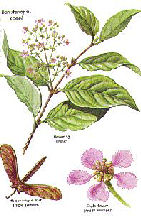AYAHUASCA: VISIONARY VINE OF THE AMAZON

Banisteriopsis caapi
Ayahuasca, caapi, kahpi, mihi, dapa, and yage are all terms used in reference to the hallucinogenic drink made from the bark of the neotropical lowland rainforest lianas, Banisteriopsis caapi and B. inebrians. The drink was originally used by the indigenous people of the upper Amazon and Orinoco rivers and is prepared by boiling the bark in water. The hallucinogens present belong to the beta-carboline class of alkaloids and the major psychoactive ingredients are harmaline, and to a lesser extent, harmine and tetrahydro harmine. In addition to the hallucinogenic effects of the beta-carbolines, Psychotria viridis or Diplopterys cabrerana , are often added. Both these plants contain dimethyl tryptamine (DMT) and it seems that the effects of DMT are strongly potentiated by the mono amine oxidase inhibiting beta-carbolines.
Current research on the pharmacological effects of beta-carbolines and ayahuasca are being undertaken by research groups at the University of California at Los Angeles as part of the Hoasca Project
There is also a growing body of evidence that points to the use of isoquinoline and tryptamine-related alkaloids such as the beta-carbolines as a strategy for the control of intestinal helminths and other microbes by forest dwelling people. It is readily accepted that hallucinogen use by the indigenous people of tropical America has a long history and is an integral part of their culture. In addition, during native ceremonies, repeated references are made to the cleansing and purifying properties of these drugs. Because these compounds are not only hallucinogens, but powerful emetics with antimicrobial and antihelminthic properties, [5-6] it is suspected that the use of ayahuasca is more than vision seeking--it is actually chemotherapy. The mode of this antihelminthic action is believed to be related to the similarity in structure of serotonin to the beta-carboline alkaloids. It is possible that these indole alkaloids are antagonists of serotonin in intestinal worm metabolism but little comparative data on the effects of naturally occurring psychoactive drugs on parasitic worms is available. Work in this area is currently underway.